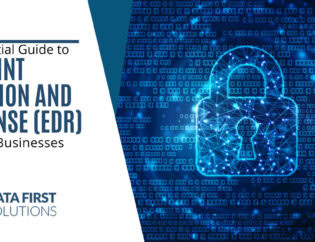A startling survey by the British Columbia Chamber of Commerce revealed that about two-thirds (61 per cent) of Canadian businesses have experienced a cybersecurity attack, and many of these breaches started with network vulnerabilities. Don’t let your business become yet another statistic. Understanding the critical value of layered Wi-Fi security is your first major step toward robust protection.
The Unseen Dangers on Your Wireless Network
Every unsecured access point is a potential entry point for cybercriminals. Threats such as man-in-the-middle attacks allow bad actors to intercept data on poorly secured or unsecured connections. Once inside, these attackers can steal credentials and other sensitive information from your network. Well-meaning employees sometimes install rogue access points to bypass restrictions and access blocked sites such as social media. However, these access points end up creating backdoors into company systems.
On the other hand, remote workers are fans of public Wi-Fi networks in cafés, and these are especially dangerous since they often require no authentication and may rely on weak encryption protocols. Threat actors position themselves in these networks to access unsecured devices. Having employees use a virtual private network (VPN) while working on public Wi-Fi ensures that they have a secure and encrypted tunnel for remote connections into the company network. This is just one of the components of a true managed, layered Wi-Fi solution.
What Is Managed, Layered Wi-Fi Security
Managed, layered Wi-Fi security is more than just a fancy router. It is a comprehensive security solution that combines multiple defence layers that work in harmony to secure your network. By doing so, it offers far better protection than standard off-the-shelf equipment. The layered approach works on three key principles:
- It uses professional-grade network equipment that implements the latest security protocols, such as WPA3.
- It provides continuous monitoring and threat detection around the clock.
- It includes expert management that adjusts and updates defences as threats evolve.
How Layered Protection Stops Specific Threats
The first layer provides powerful authentication and encryption. The WPA3 encryption used in modern professional-grade equipment prevents unauthorized access and reading of data transmitted through your network. Even when passwords are compromised, multi-factor authentication adds a critical security barrier. Additional layers provide specialized protection as follows:
- Creating separate guest networks to isolate visitor traffic from core business systems.
- Network segmentation using virtual local area networks (VLANs) to contain potential breaches to limited network segments.
- Firewalls and intrusion detection systems (IDS) constantly monitor and block suspicious network activity.
Essentially, a layered approach creates a security posture that adapts to new challenges, and these are not features that most SMBs can implement alone.
The Benefits Beyond Security
While managed layered Wi-Fi security does an excellent job of preventing breaches, its benefits go beyond mere security. First, your teams gain productivity by using reliable, high-performance Wi-Fi since you eliminate downtime caused by network issues and security incidents. This kind of operational stability keeps business momentum and maintains customer trust.
These solutions also ease compliance with Canadian privacy regulations, such as PIPEDA, with providers such as Data First Solutions helping you document controls and build an audit-friendly security posture. In the end, you gain enterprise-grade protection without the often-accompanying enterprise-level complexity. This lets you focus on your business rather than your network.
Why SMBs Overlook Managed, Layered Wi-Fi Security, and the Consequences
Many small and medium-sized business owners suffer from security fatigue and are overwhelmed by the complexities of cybersecurity. Between rising costs and staffing issues, some of these owners simply tune out, and that is exactly what hackers want.
The financial consequences are quite severe, with reports indicating that Canadian businesses lose an average of CA$6.98 million per breach in direct financial losses alone. Beyond these immediate losses, companies face loss of customer trust and damaged reputations. Recovering from a single breach often costs more than years of professional protection.
Implementing Managed Wi-Fi Security in Your Business
To implement managed layered Wi-Fi security in your business, you need to conduct a professional assessment of your current network infrastructure to reveal your true security posture and the necessary improvements. This is a quick two-step process that involves:
- Identifying vulnerabilities, such as legacy systems or weak encryption protocols.
- Documenting all devices that connect to your network.
Next, choose a provider that offers a strong suite of managed layered Wi-Fi features, such as:
- Automatic firmware updates that patch vulnerabilities without your intervention.
- 24/7 monitoring that detects and responds to threats before they cause damage.
- Strong encryption and multi-factor authentication as standard.
Beyond Technology: The Human Element
Even the most advanced technologies require knowledgeable users, and thus, a key aspect of comprehensive security is employee training. Teach your team to identify suspicious networks within your premises and to report unusual network activity, such as frequent disconnections. Most importantly, ensure that they understand the proper connection procedures for remote work.
Finally, clear Wi-Fi policies complete your security framework. Implement the following:
- Define acceptable use of business networks and devices, and implement network restrictions just in case policies are violated.
- Establish protocols for connecting personal devices to company networks.
- Outline incident response plans for potential security breaches.
Covering these human elements of Wi-Fi security adds an extra layer of security and magnifies the effectiveness of your technical measures.
Your Path to Layered, Wi-Fi Security
Securing your business Wi-Fi should not be an afterthought. It deserves professional layered protection that matches its importance to your business operations. Managed layered Wi-Fi security ensures that your company network is secure by detecting threats that basic systems miss and isolating them before they cause harm.
Don’t wait for a breach to reveal the vulnerabilities in your network. At Data First Solutions, we offer specialized managed network security tailored to Canadian SMBs. Explore our managed security services and learn about ring-fencing techniques for additional security layers.
Contact us today to connect with a consultant and discover how an IT optimization plan can strengthen your wireless network with enterprise-grade protection.







